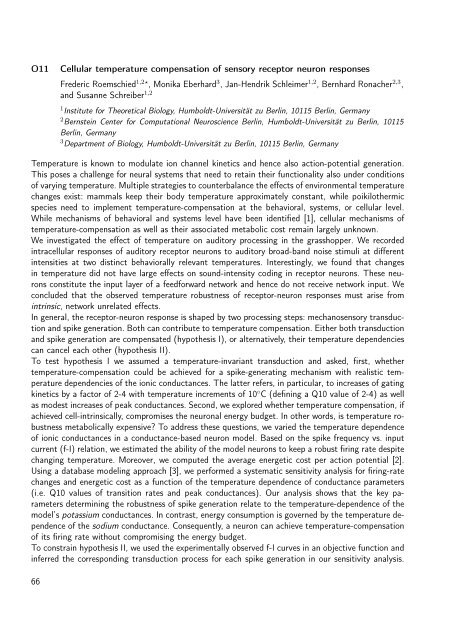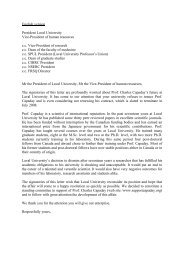Untitled - Laboratory of Neurophysics and Physiology
Untitled - Laboratory of Neurophysics and Physiology
Untitled - Laboratory of Neurophysics and Physiology
Create successful ePaper yourself
Turn your PDF publications into a flip-book with our unique Google optimized e-Paper software.
O11<br />
Cellular temperature compensation <strong>of</strong> sensory receptor neuron responses<br />
Frederic Roemschied 1,2⋆ , Monika Eberhard 3 , Jan-Hendrik Schleimer 1,2 , Bernhard Ronacher 2,3 ,<br />
<strong>and</strong> Susanne Schreiber 1,2<br />
1 Institute for Theoretical Biology, Humboldt-Universität zu Berlin, 10115 Berlin, Germany<br />
2 Bernstein Center for Computational Neuroscience Berlin, Humboldt-Universität zu Berlin, 10115<br />
Berlin, Germany<br />
3 Department <strong>of</strong> Biology, Humboldt-Universität zu Berlin, 10115 Berlin, Germany<br />
Temperature is known to modulate ion channel kinetics <strong>and</strong> hence also action-potential generation.<br />
This poses a challenge for neural systems that need to retain their functionality also under conditions<br />
<strong>of</strong> varying temperature. Multiple strategies to counterbalance the effects <strong>of</strong> environmental temperature<br />
changes exist: mammals keep their body temperature approximately constant, while poikilothermic<br />
species need to implement temperature-compensation at the behavioral, systems, or cellular level.<br />
While mechanisms <strong>of</strong> behavioral <strong>and</strong> systems level have been identified [1], cellular mechanisms <strong>of</strong><br />
temperature-compensation as well as their associated metabolic cost remain largely unknown.<br />
We investigated the effect <strong>of</strong> temperature on auditory processing in the grasshopper. We recorded<br />
intracellular responses <strong>of</strong> auditory receptor neurons to auditory broad-b<strong>and</strong> noise stimuli at different<br />
intensities at two distinct behaviorally relevant temperatures. Interestingly, we found that changes<br />
in temperature did not have large effects on sound-intensity coding in receptor neurons. These neurons<br />
constitute the input layer <strong>of</strong> a feedforward network <strong>and</strong> hence do not receive network input. We<br />
concluded that the observed temperature robustness <strong>of</strong> receptor-neuron responses must arise from<br />
intrinsic, network unrelated effects.<br />
In general, the receptor-neuron response is shaped by two processing steps: mechanosensory transduction<br />
<strong>and</strong> spike generation. Both can contribute to temperature compensation. Either both transduction<br />
<strong>and</strong> spike generation are compensated (hypothesis I), or alternatively, their temperature dependencies<br />
can cancel each other (hypothesis II).<br />
To test hypothesis I we assumed a temperature-invariant transduction <strong>and</strong> asked, first, whether<br />
temperature-compensation could be achieved for a spike-generating mechanism with realistic temperature<br />
dependencies <strong>of</strong> the ionic conductances. The latter refers, in particular, to increases <strong>of</strong> gating<br />
kinetics by a factor <strong>of</strong> 2-4 with temperature increments <strong>of</strong> 10 ◦ C (defining a Q10 value <strong>of</strong> 2-4) as well<br />
as modest increases <strong>of</strong> peak conductances. Second, we explored whether temperature compensation, if<br />
achieved cell-intrinsically, compromises the neuronal energy budget. In other words, is temperature robustness<br />
metabolically expensive To address these questions, we varied the temperature dependence<br />
<strong>of</strong> ionic conductances in a conductance-based neuron model. Based on the spike frequency vs. input<br />
current (f-I) relation, we estimated the ability <strong>of</strong> the model neurons to keep a robust firing rate despite<br />
changing temperature. Moreover, we computed the average energetic cost per action potential [2].<br />
Using a database modeling approach [3], we performed a systematic sensitivity analysis for firing-rate<br />
changes <strong>and</strong> energetic cost as a function <strong>of</strong> the temperature dependence <strong>of</strong> conductance parameters<br />
(i.e. Q10 values <strong>of</strong> transition rates <strong>and</strong> peak conductances). Our analysis shows that the key parameters<br />
determining the robustness <strong>of</strong> spike generation relate to the temperature-dependence <strong>of</strong> the<br />
model’s potassium conductances. In contrast, energy consumption is governed by the temperature dependence<br />
<strong>of</strong> the sodium conductance. Consequently, a neuron can achieve temperature-compensation<br />
<strong>of</strong> its firing rate without compromising the energy budget.<br />
To constrain hypothesis II, we used the experimentally observed f-I curves in an objective function <strong>and</strong><br />
inferred the corresponding transduction process for each spike generation in our sensitivity analysis.<br />
66



